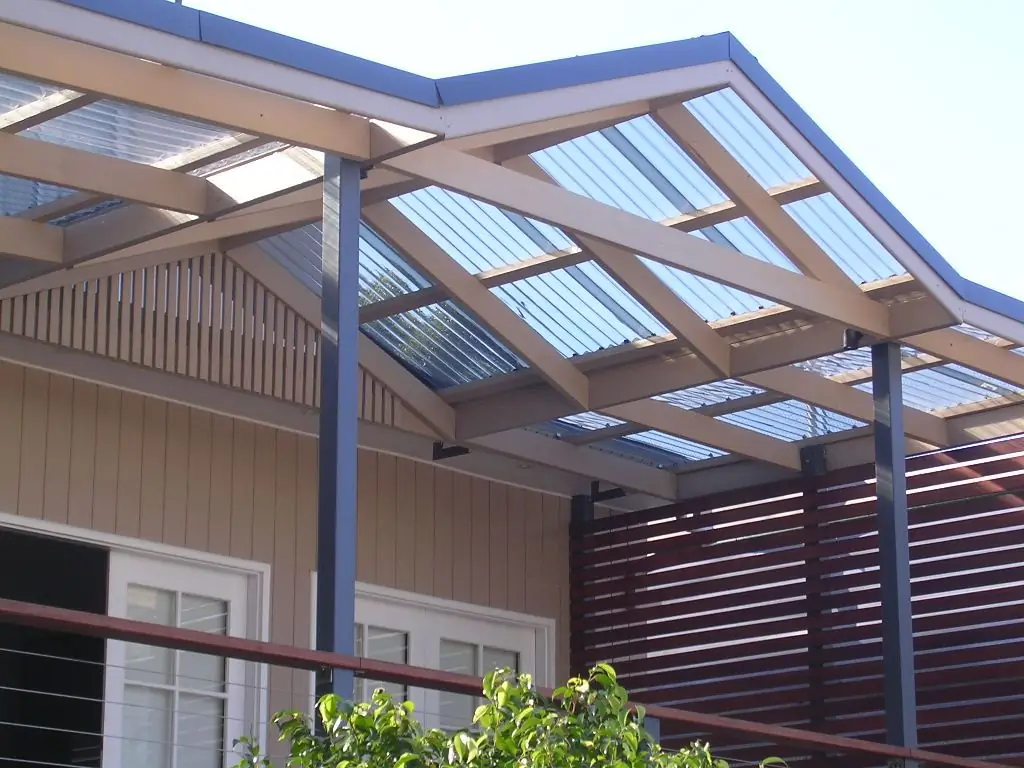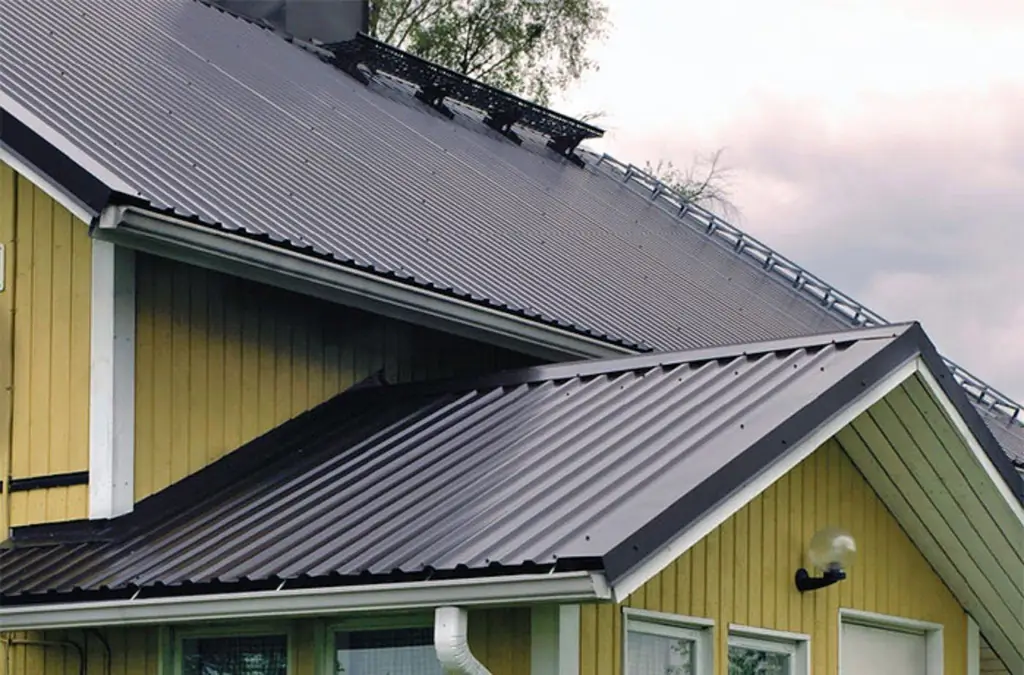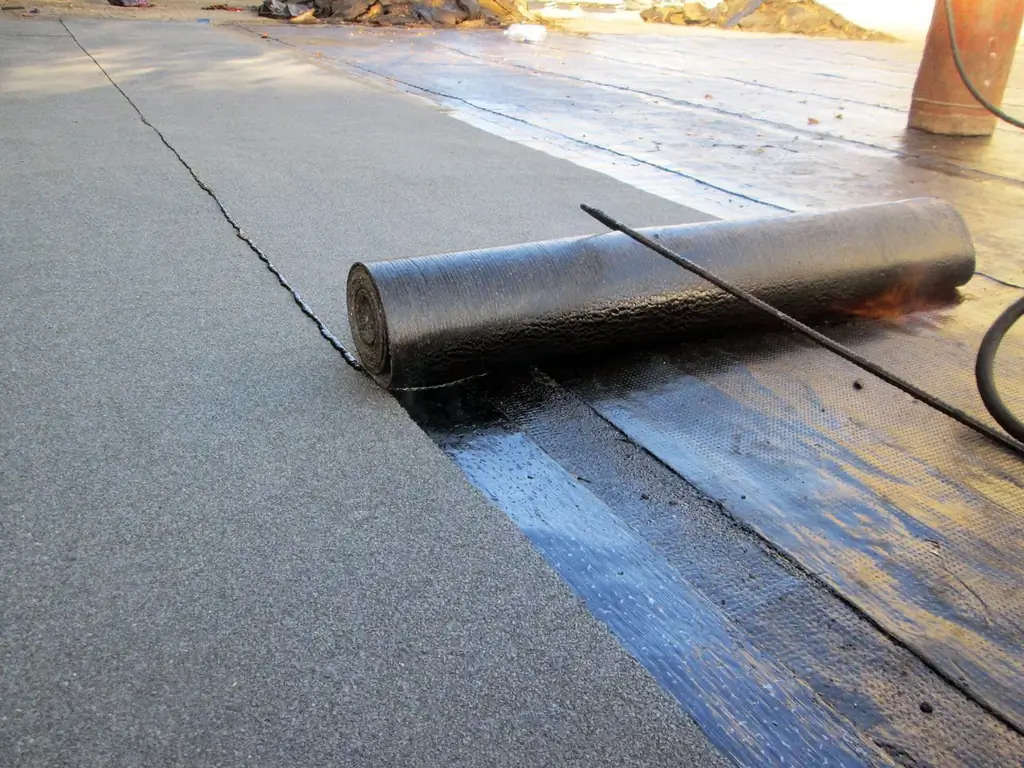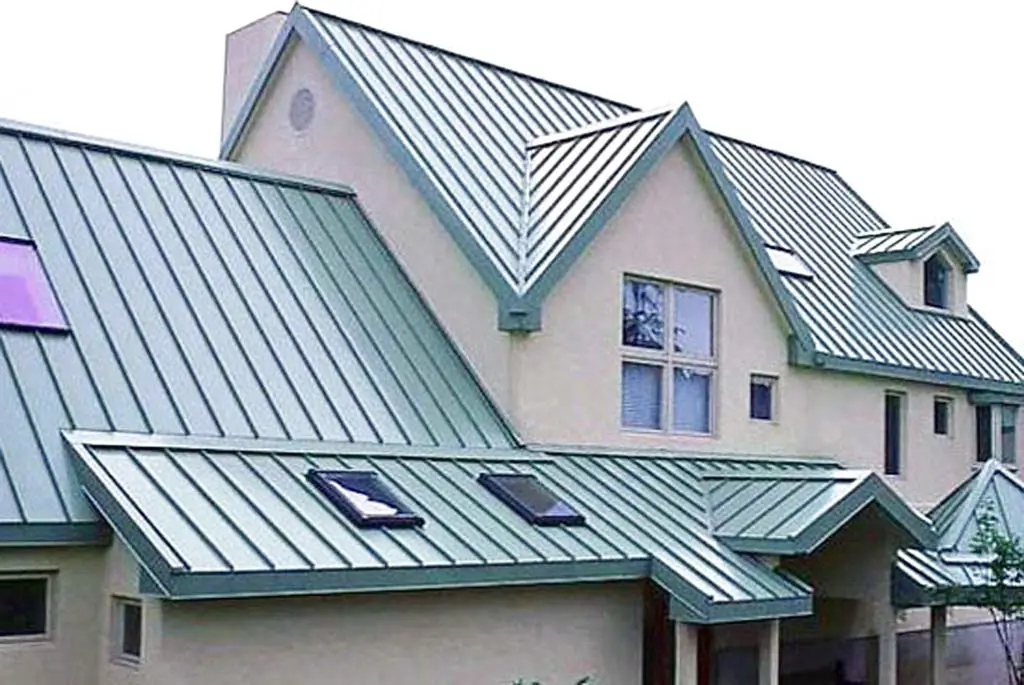
Table of contents:
- Author Bailey Albertson [email protected].
- Public 2023-12-17 12:53.
- Last modified 2025-06-01 07:32.
How to make a polycarbonate roof

Polycarbonate is a new building material and has only recently been used for roofing. It is characterized by sufficient strength, transparency, stability and the possibility of quick installation. It is because of this that the material is so popular. Also, its properties allow you to make a roof of completely unimaginable shapes, and even an inexperienced builder can do this.
Content
-
1 Features and characteristics of polycarbonate roofing
-
1.1 Polycarbonate for roof
1.1.1 Video: how to choose a good polycarbonate
- 1.2 Polycarbonate roof for home
- 1.3 Polycarbonate roof for garage
- 1.4 Polycarbonate roof for terrace
- 1.5 Video: rules for installing cellular polycarbonate
-
-
2 Tool for polycarbonate roofing
2.1 Video: how to cut cellular polycarbonate
-
3 Rules for the construction of a polycarbonate roof
3.1 Polycarbonate roof slope
-
4 Features of mounting a polycarbonate roof
- 4.1 Sealing the polycarbonate roof
- 4.2 Errors when installing a polycarbonate roof
-
5 Features of the operation of the polycarbonate roof
- 5.1 Service life of polycarbonate roof
-
5.2 Polycarbonate roof repair
5.2.1 Video: replacing the old polycarbonate on the roof
Features and characteristics of polycarbonate roofing
Polycarbonate is a sheet polymer material, and it surpasses many similar materials in its performance characteristics. For example, it is 200 times stronger than glass and 8 times stronger than plexiglass.

Polycarbonate can be of different colors
In addition to strength, its other characteristics are also valuable:
- light weight;
- flexibility;
- ease of processing and installation;
- resistance to fire, chemicals and aggressive environment;
- impact resistance;
- long service life.
The area of application of polycarbonate is quite wide, including it is suitable for arranging the roof

Polycarbonate is stronger than glass
Roof polycarbonate
Polycarbonate allows you to increase the functionality of your own home. For example, if you wish, you can equip the second floor, which will serve as a pavilion, greenhouse or greenhouse. This allows you to use space rationally, which is especially important if the area of the site is too small to implement all the ideas.

The round roof will keep snow from lingering
Polycarbonate for the roof is a material with a multi-chamber honeycomb structure, which is formed by several stiffening ribs. This type of material is called honeycomb because it resembles a honeycomb of bees.
There are other types as well:
-
profiled - has a wavy or trapezoidal profile;

Profiled polycarbonate Profiled polycarbonate has waves
-
monolithic - a material without voids, outwardly resembling silicate glass.

Monolithic polycarbonate Monolithic polycarbonate is void free
This material can have different thicknesses, and this parameter is very important for the manufacture of roofs of various buildings:
- for a private house, you can use polycarbonate with a thickness of 8 or 16 mm (the second option is suitable for arranging surfaces with a large area, since it can withstand significant loads);
- for canopies, garages or terraces, material with a thickness of 8 mm is suitable;
- greenhouses and canopies can be made of 3.5 and 4 mm polycarbonate.
You can also choose a color, and this parameter affects the performance of the material:
-
for the construction of a garage, it is recommended to choose a colored material, transparent in this case is not suitable due to the possible occurrence of a greenhouse effect, which is detrimental to the car;

Garage with polycarbonate roof Transparent polycarbonate cannot be used for garage
- it is recommended to install white plastic with a throughput of 50-70% over the terrace, which will create a comfortable, cool microclimate in this room;
-
transparent materials can be used for swimming pools and awnings.

Indoor pool Roof protects the pool from debris
Video: how to choose a good polycarbonate
Polycarbonate roof for home
A polycarbonate roof is erected only over those rooms that do not require the arrangement of an insulated roofing cake. In the case of a residential building, these are most often attics, terraces, attics or balconies. The shape of the roof can be absolutely any, since the material is quite flexible and allows you to construct various structures.

Polycarbonate can be used for loft or attic roof
The peculiarity of a polycarbonate roof for a house is that it does not require the arrangement of a rafter system in its classical sense. In addition to the rafters, profiles are installed and a frame is formed. Polycarbonate profiles can be split and one-piece. They are characterized by increased tightness and strength, low weight, protection from ultraviolet rays, and they can also be chosen in a color that matches the main canvas.
The process of installing a polycarbonate roof on a residential building takes place according to the following plan:
-
Installation of rafters. It is recommended to use a bar with a section of 60 * 40 mm or 60 * 80 mm. Install 1.01 m if center rafters and 1.04 m between side rafters.

Rafters for polycarbonate To install polycarbonate, you need to mount profiles
-
Installation of profiles. They need to be fastened to the end and connecting profiles. Additionally, it is recommended to fix the limiters. They should be placed at a distance of 2 cm from the edges.

Assembly diagram of polycarbonate connecting profile You can connect sheets with profiles or sealant
-
End protection. The side surfaces must be protected from ultraviolet rays with adhesive tape. Moreover, the upper part can be pasted over with ordinary tape, and the lower one with perforated.

Polycarbonate sheet end The ends of the polycarbonate must be sealed with tape
- Laying the material. After installing the frame, polycarbonate sheets should be mounted directly. This must be done in such a way that the joints are tight. This will make the roof structure waterproof. Additionally, the seams can be finished with waterproofing mastic.
- Fastening of covers and plugs.
Polycarbonate roof for garage
Separately, polycarbonate roofs for the garage are not erected. Most often, a full-fledged structure is constructed from this material, which can have completely different shapes. To mount the structure, you must:
- Remove part of the soil 30-35 cm deep.
- Install the formwork, which is recommended to be reinforced with props, and then cover the structure with foil. Additionally, you can insulate this structure.
- Make wells for posts 1 m deep. The diameter of the wells can be 20 cm. In these holes you need to install posts that can be made of asbestos-cement pipes.
-
Now we need to prepare the site for the garage itself. It needs to be covered with sand, and it should be moistened and thoroughly tamped. Next, the site should be poured with cement mortar, and the pipes must also be poured. After that, plates must be installed in the pipes and the structure must be left to harden for several days.

Columnar base for garage Asbestos-cement pillars are suitable for the garage foundation
- After the concrete has hardened, attach the bottom trim to the plates. To do this, it is recommended to take boards with a section of 15 * 5 cm. You need to fasten them on the edge, two pieces at a time.
- Mount wall posts.
- Make the top harness.
- Sheathe the entire structure with sheets of cellular polycarbonate.
- Install vertical beams for the roof, on which you need to fix the rafters and lathing directly for polycarbonate sheets.
-
Remove the film from the material.

Spacious garage with polycarbonate roof After installation, the film must be removed from the polycarbonate
Polycarbonate roof for terrace
For the roof of the terrace, you can use lighter polycarbonate, which is much cheaper, which means that the whole structure will be democratic.

The polycarbonate roof will provide the necessary light to the terrace and protect it from rain
An arched roof is most often constructed over the terrace. It's very simple to make it:
- Make the elements of the rafter system. They can be made of metal or wood. Treat these elements with special compounds to protect them from moisture.
- Install the rafters on the upper deck rail. Self-tapping screws can be used for fastening.
- Cut polycarbonate sheets into pieces of the required size.
-
Drill holes in the material for fastening. It is recommended to install them every 30-40 cm. The diameter of the holes should be 3-5 mm larger than the diameter of the screws. This is to ensure that the polycarbonate is not damaged by thermal expansion.

Fixing scheme for polycarbonate with self-tapping screws Do not over tighten the screws on polycarbonate
-
Attach a profile to the extreme rafter leg, insert the first sheet of polycarbonate into it. Remember to mount them along, not across. It is necessary to fix polycarbonate sheets with special galvanized self-tapping screws, and it is necessary to protect the attachment point with thermal washers or rubber seals. This must be done, otherwise water will flow into the holes.

Layout of polycarbonate sheets Stiffening ribs should be placed along the rafters
-
The bottom of the material must be sealed with perforated tape, otherwise debris will accumulate in the cavities.

End protection circuit For the ends, you can use regular and perforated tape
Video: rules for installing cellular polycarbonate
Polycarbonate Roofing Tool
Working with polycarbonate is possible only if you have a special tool:
-
Circular saw or grinder. This tool can only be used to cut thick polycarbonate. You can make an even cut if the sheet is fixed on two sheets of fiberboard, and the cut line must exactly coincide with the line of joint of two fiberboard boards. Work can be carried out in a circle on metal with a diameter of 25 cm, while it is recommended to adjust the rotation speed of the disc and set it to 4000 rpm. Before cutting, it is recommended to moisten the polycarbonate sheet with water, and after work, process the cut point with fine sandpaper.

Worker cuts polycarbonate with a grinder To cut polycarbonate you need a grinder or a jigsaw
-
Electric jigsaw. This tool is ideal for cutting polycarbonate in the event that the roof will be complex shapes. Moreover, you can work even with the thinnest material, it can be cut into several sheets at once. To do this, two boards must be laid on the cardboard with a slight gap (no more than 5 mm). Lay a sheet of polycarbonate plastic on them and secure. For cutting into a jigsaw, insert a carbide file for metal, and you need to choose the one that has frequent and low teeth.

Electric jigsaw Together with the jigsaw, you must use a file with fine, frequent teeth.
-
Stationery knife. When using this tool, the cut will be perfectly flat, but you will not be able to make it quickly. And this is the only drawback. To cut a polycarbonate sheet, you need to make a marking with a knife, laying it on a flat surface. Further, according to the marking, make an incision along the stiffening rib. Make a fold along the notch line, cut the bottom layer of plastic. In the case of cutting monolithic polycarbonate, this procedure can be carried out without bending, it is enough to draw along the guide with a knife.

Stationery knife It will take a long time to cut polycarbonate with a stationery knife
-
Hacksaw. It is recommended to use this tool only if there is no other tool at hand and you cannot get it. Careless actions can easily damage the sheet. If, nevertheless, there is no other way out, then you need to fix the polycarbonate sheet, make an incision according to the markings made earlier, and then process the edges with a clerical knife and sandpaper.

Hacksaw A hacksaw is not the best tool for cutting polycarbonate
- Cutters. This tool is used if they want to get an openwork pattern on a plastic sheet. With it you can round corners, cut edges, cut curved elements, and engrave. To do this, fix the polycarbonate sheet on a flat surface, install the cutter in the manual machine, insert the roller on top. When cutting out curved shapes, you need to prepare cardboard stencils in advance. Additionally, care must be taken to remove sawdust in a timely manner, as they can damage the material itself. To do this, you can install a fan that will immediately blow them off during operation.
Video: how to cut cellular polycarbonate
Polycarbonate roofing rules
When arranging a roof made of polycarbonate plastic, certain rules must be followed:
- sealing of seams can be carried out exclusively with neutral compounds, polyurea is ideal for this;
- polycarbonate sheets have a special coating against ultraviolet radiation, it must be directed upward for the protection to work;
- holes for self-tapping screws can be made not round, but oval, so thermal play will be ensured;
- when installing a roof, it is necessary to exclude a person's walking on the material;
- it is recommended to pre-paint metal parts white, this will not allow the polycarbonate to heat up locally;
- it is necessary to exclude direct contact of polycarbonate plastic with wood and metal; rubber gaskets must be placed between these materials.
Polycarbonate roof slope
There are features in the arrangement of the lathing, which is able to set the necessary slope for the roof. The minimum slope should be 30 degrees. Despite the fact that the material is considered durable, it is still not able to withstand heavy snow loads. The optimal value is 50.

A polycarbonate roof should be as steep as possible
The calculation of the parameter largely depends on the characteristics of the climate in your area. The more snow falls in a year, the steeper the roof should be. In this case, an arched structure is considered ideal, which practically does not retain snow on its surface. And if we take into account the even surface of the material, then even an angle of 30 degrees is sometimes enough.
Features of installing a polycarbonate roof
The service life of a polycarbonate roof depends not only on the material used, but also on the correct installation.
Polycarbonate roof sealing
Sealing the seams and ends of polycarbonate is a very important stage in the arrangement of a plastic roof. There are different sealants that can be used when working with polycarbonate:
-
Silicone sealant. This material has a high level of adhesion, so it can be applied to any material. It is resistant to constant temperature changes, therefore it is suitable for sealing joints. The silicone sealant has a wide range of colors, which allows it to be matched to polycarbonate of any color. A silicone sealant is usually applied under the polycarbonate sheet prior to installation. They can also seal up all the cracks and joints. This insulation will prevent moisture from penetrating under the roof and allow the polycarbonate to expand thermally.

Roof Silicone Sealant The silicone sealant can be matched to the color of the polycarbonate
- Connecting tape. It is used only for insulation of honeycomb material. This tape consists of two layers: sticky, which is carefully fixed to the plastic, and the outer one, which is quite resistant to abrasion and atmospheric precipitation. It is so elastic that it can deform along with the expansion and contraction of the polycarbonate itself. Also, such a tape can prevent debris and water from entering the honeycomb of the material, which increases its service life. The most commonly used tape is perforated.
Errors when installing a polycarbonate roof
Despite the ease of installation of polycarbonate sheets, some errors may still occur:
- Incorrectly selected crate, its inconsistency with the thickness of the polycarbonate. The distance between the rafters must be strictly observed and not too large. This can result in sheet bending and deterioration.
- Use of aluminum profiles as load-bearing. Not all of them are able to cope with such a load. That is why it is necessary to fasten the sheets to the rafters.
- Strong fixing of self-tapping screws. As a result, when exposed to the sun, the leaf expands and breaks, since there is no reserve for this.
- No thermal washers or rubber seals. Because of this, at the junction, the polycarbonate plastic sheet may be damaged.
- The protective transport foil has not been removed. If this is not done immediately after installation, it will gradually flake off during the operation of the roof and spoil its appearance.
Features of the operation of the polycarbonate roof
Polycarbonate is a durable material, but only if the structure based on it is used correctly. After installing the polycarbonate roof, you need to ensure its proper maintenance:
- During the summer period, periodically wipe the roof, timely eliminate structural violations, if they appear, clean them of dirt and debris. But for cleaning the surface, in no case should you use abrasive chemicals, powder. The roof can be washed only when the material is not heated by the sun.
- Periodically adjust the pressure level of the thermowells.
- In winter, remove the snow, but in no case scrape it off with hard objects, as this can violate the integrity of the polycarbonate.

The polycarbonate roof must be cleaned in time
Polycarbonate roof service life
The average service life of polycarbonate is considered to be a period of 10 years, but it can be significantly increased if the rules are carefully followed:
- storage before installation (this must be done in a well-heated room in the factory packaging and protective film, and the packages should not be stacked end-to-end);
- transportation (can only be transported in a prone position in the original packaging, while they must be carefully fixed);
- installation;
- exploitation.
Polycarbonate roof repair
It is possible to extend the service life of a polycarbonate roof if structural violations and repairs are promptly eliminated. They can consist either in replacing a damaged sheet, or in eliminating the broken integrity of the sheet, if the crack is insignificant.
If a small crack or hole has formed on the sheet, then you can:
- seal with silicone sealant (it can be matched to the color of the material itself);
- pull off with thermal washers and self-tapping screws.
In the event that the damage is significant, it is worth replacing the damaged sheet with a new one. This must be done in the following sequence:
- Remove the damaged sheet so as not to damage the nearby material.
- Remove the sealant from the rafter and then apply a new layer.
- Lay a new polycarbonate sheet, in advance on it you need to make holes for fasteners. Fix with self-tapping screws, insulating them with thermal washers.
In the event that the extreme sheet is to be replaced, the scheme of work is almost the same, but the material must be inserted into the limiting profile.
Video: replacing the old polycarbonate on the roof
Polycarbonate is a very reliable and practical material that can be used to equip the roofs of gazebos, greenhouses, terraces, canopies and even residential buildings. And all because of the attractive cost and the ability to do the installation yourself.
Recommended:
The Welded Roof, Including The Features Of Its Construction, Operation And Repair, As Well As How To Avoid Mistakes During Installation

The main features and characteristics of the overlaid roof. Materials and tools required for the job. Installation, operation and repair of the overlaid roof
Roofing From A Profiled Sheet, Including The Features Of Its Design And Operation, Repair, As Well As How To Avoid Mistakes During Installation

What kind of profiled sheet can be used for the roof. DIY cold and insulated roof device. What mistakes are possible. Features of operation and repair
Roll Roofing, Including The Features Of Its Construction, Operation And Repair, As Well As How To Avoid Mistakes During Installation

The difference between roll roofing and modern and Soviet counterparts. Can I use roll roofing on a pitched roof? How to install it and when to repair it
Roofing Made Of Corrugated Board, Including The Features Of Its Design And Operation, Repair, As Well As How To Avoid Mistakes During Installation

Features and characteristics of corrugated roofing. Types of roofing sheeting. Calculation of the amount of material for the roof. Features of installation and operation
Seam Roofing, Including The Features Of Its Construction, Operation And Repair, As Well As How To Avoid Mistakes During Installation

Features of the design and characteristics of the folded roof. Required tools and installation sequence. Repair and operation of seam roofing
